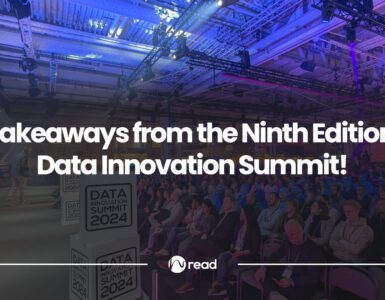In part one, we covered some of the popular trends regarding artificial intelligence. Consequently, we looked into key trends that have not only captured the attention of various sectors but have also resonated within the media narrative.
Join us as we continue our exploration in part 2 of “The 2023 Evolution of Data, Analytics and AI” series! In this part, we take a closer look at data management, highlighting key trends and transformations that have gained significant momentum in 2023, surpassing the developments of the preceding years.
In addition, we cover the growing adoption of cloud-native applications, including multi-cloud strategies and hybrid cloud platforms, data lakes and lakehouses, the development of low-code/no-code applications, and the powerful synergy of data democratization, data mesh, and data fabric.


Robust data management is the force transforming unstructured data into a powerful resource, fueling progress in 2023 and beyond. Therefore, this year witnessed substantial shifts in how we harness this invaluable asset, making it accessible, adaptable, and relevant to diverse applications.
Data Management with Cloud-Native Applications
The concept of ‘cloud-native’ has become a widespread topic within data-driven organizations for quite some time, often dismissed as a fleeting tech trend. However, this year witnessed its rising from a buzzword to a transformative trend.
Cloud-native applications shift the way in which organizations handle and leverage their data. Unlike traditional applications, cloud-native applications are built to operate seamlessly within cloud environments, fostering agility, scalability, and efficiency. This year, organizations across industries have increasingly acknowledged the imperative to transition from outdated legacy systems towards cloud-native architectures. This transition facilitates a more agile and responsive management of extensive datasets, aligning organizations with the evolving demands of the digital landscape.
Transformations Behind Cloud-Native Applications
- Cloud-native applications respond to the vast data volumes with scalable solutions, conveniently adapting to the increasing demand for data processing.
- The dynamic infrastructure of cloud-native applications allows seamless expansion or contraction, ensuring optimal performance.
- These applications advocate for microservices architecture, fostering modular development and updates.
- This approach minimizes downtime and elevates the overall reliability of systems.
2023 was Dedicated to Multi-Cloud Strategies
The adoption of multi-cloud strategies within technology and business continues to accelerate – even faster now. The once-simple landscape of single-cloud data management has given way to a more complex, but potentially more rewarding, multi-cloud reality.
Organizations are increasingly embracing this approach, distributing workloads across diverse cloud platforms to boost flexibility, hedge against risks, and optimize performance. In recent years, this widespread adoption has brought about tangible benefits, such as increased agility and cost optimization.
Factors Driving Companies Toward the Multi-Cloud Approach
- Tailoring cloud services to specific needs prevents vendor lock-in and optimizes operations by selecting providers with the ideal features, capabilities, and pricing for each workload.
- Employing a multi-cloud strategy boosts capabilities in redundancy and disaster recovery, as well as allows seamless transition to an alternative provider during service disruptions. This ensures operational continuity and minimizes the impact of interruptions, enabling sustained operations in adverse conditions.
- Selecting the most economical cloud service for each workload optimizes costs. A multi-cloud strategy compares pricing models, choosing the most affordable option for each use case. This approach enhances the efficient management of cloud spending, preventing unnecessary expenses.
- A multi-cloud strategy leverages the strengths of each provider, optimizing resources for specific workloads and boosting user experience.
- A multi-cloud strategy promotes innovation through access to diverse technologies and tools. Leveraging multiple providers allows experimentation with new technologies without committing to a single cloud service, ensuring a competitive edge.
Hybrid Cloud Platforms
In highly regulated sectors like healthcare, pharmaceuticals, energy, and the public sector, a 2023 paradigm shift has seen a growing adoption of hybrid cloud due to strict regulations.
This notable trend, while not entirely new, has witnessed a significant uptick in adoption by organizations in 2023, marking a substantial increase compared to the previous few years. The hybrid cloud platform extends beyond compliance, offering these industries a strategic advantage in navigating the complexities of regulatory environments and enhancing overall operational efficiency.
This approach fuses the flexibility of public cloud infrastructure with the security of private cloud solutions, creating a tailored union for industries requiring precise data storage and management.
Embracing the Increased Hybrid Cloud Corporate Adoption
- Hybrid cloud provides both control and scalability by allowing sensitive data in private clouds and leveraging public cloud resources for less critical tasks.
- Access to the vast resources of public clouds empowers industries to rapidly develop and deploy new applications, improving responsiveness and competitiveness.
- Hybrid cloud enables organizations to leverage the cost-efficiency of public clouds for variable workloads while maintaining on-premises investments for critical data, leading to optimal resource allocation.
Data Lakes and Lakehouses
Recent years have embraced the tidal wave of adopting data lakes and lakehouses. These solutions break down data silos, fueling agile decision-making for managing and analyzing large volumes of data.
As organizations have struggled to manage and process their data, the need for a more flexible and scalable storage solution roared into existence. Moreover, data lakes were designed to shatter the chains of siloed data. Within a unified data lake, structured and unstructured data coexist seamlessly, readily accessible for exploration and analysis.
Data Lakes and Lakehouses Transformations:
Data lakes and lakehouses continued their evolution in 2023, and are set to become more mainstream in the forthcoming years. Several factors contribute to the sustained interest in data lakes and lakehouses:
- Breaking down data silos: The rise of data lakes and lakehouses has transformed data management by dismantling traditional silos. Historically, organizations struggled with isolated data repositories, hindering collaboration and analysis. With the adoption of data lakes, the barriers between structured and unstructured data have crumbled, creating an environment where information flows freely. This liberation from silos fosters cross-functional collaboration and enables a holistic view of organizational data.
- Democratizing data exploration and analysis with agile access: Data lakes and lakehouses enable self-service querying and analysis of diverse data formats without the need for pre-processed data, offering flexible exploration for analysts and data scientists. This enhances agility and speeds up time-to-insights, empowering teams to adapt to market shifts quickly.
- Scalability and performance optimization: In 2023, data lakes and lakehouses have adapted to growing volumes, merging flexibility and optimized performance. This union delivers faster queries, efficient processing, and consistent performance, enabling organizations to confidently handle the data deluge.
- Cost-effectiveness and resource optimization: The rigidity of data warehouses carries a high cost. This approach has enabled organizations to analyze essential data, reducing storage costs and maximizing value per byte. This optimization not only allocates resources efficiently but also opens up a budget for more data exploration and innovation. Essentially, data lakes and lakehouses are enabling organizations to unleash their full potential cost-effectively.
- Real-time insights for agile decision-making: Agility is paramount in business today. Data lakes and lakehouses act as catalysts for accelerating agile decision-making processes. By providing a flexible storage solution, organizations are able to adapt to changing circumstances. Moreover, real-time access to comprehensive datasets allows decision-makers to make informed choices promptly, enhancing the responsiveness and adaptability of the entire enterprise.
Low-code/No-code Application Development
2023 marked an increase in the adoption of low-code platforms by organizations. This recent trend is fueled by the need for quick development of consumer-centric and internal applications, driven by a strategic push for heightened agility in preparation for a potential recession.
“According to Harvard Business Review, low-code/no-code platforms have evolved from just facilitating function-specific tools to making it possible for a broader range of business employees to truly own their automation and build new software applications with no coding while increasing organizational capacity.”
The appeal of no-code and low-code platforms empowers non-technical employees to be part of application development and streamlining the software development process for businesses of all sizes. As 2023 comes to an end, the trends in the adoption and utilization of these platforms are poised for further growth.
Low-code/No-code Transformations:
Organizations across industries have witnessed the incredible power of low-code/no-code development in recent years. It’s not just a future promise for data management; it’s a game-changer that has delivered tangible results in 2023:
- Improved agility: Low-code enables rapid app development with minimal coding and drag-and-drop functionality. Reusable components eliminate the need for coding from scratch, accelerating innovation.
- Cost savings: Rapid low-code app development significantly reduces costs and dependency on large developer teams. Workflow automation unlocks savings for investment in growth areas.
- Higher productivity: Low-code shortens development cycles, implementation times, therefore reducing technical debt. Democratizes AI access, seamlessly integrating it into process automations for increased efficiency.
- Improved collaboration: Low-code platforms foster efficient collaboration, leading to faster problem resolution. Shared workspaces facilitate easy tool sharing and integration for smoother development cycles.
- Better customer experience: Low-code’s faster response times enhance customer experience, impacting brand loyalty and differentiation. As a result, it enables continuous adaptation to evolving customer needs.
- Effective risk management and governance: Low-code delivers speed in rolling out new functionalities, ensuring compliance with changing regulations. Moreover, AI-powered low-code solutions provide robust guardrails for data privacy and security.
- Faster integration: Enterprise-class low-code platforms offer pre built integrations, consequently reducing the time to connect with various tools and services. Streamlines integration with databases, cloud services, RPA bots, AI tools, and APIs from hours to minutes.
Data Democratization – Data Mesh – Data Fabric
Finally, in 2023, data management has continued to prosper through a powerful synergy: data democratization – data mesh – data fabric. Data democracy empowers everyone, not just data scientists, to leverage insights and drive agility and innovation. This ongoing shift is being fueled by two architectural approaches:
Decentralizing ownership and packaging data as self-contained, well-defined products empowers domain experts to manage and distribute their data assets. Think of it as a network of data shops, each specializing in a specific domain. Not only this fosters faster data delivery but also increased data quality, and a culture of data ownership.
Moreover, this intelligent layer weaves together the diverse data landscape, providing a unified view and seamless access across platforms and environments. It automates data integration, governance, and delivery, serving as the connective tissue that fosters collaboration and empowers self-service analytics.
Data Democratization – Data Mesh – Data Fabric Transformations:
- Faster time to insights: No more waiting for IT bottlenecks. Users can access and analyze data independently, accelerating decision cycles and boosting competitive advantage.
- Improvement in data quality: Domain ownership fosters accountability and incentivizes data stewards to prioritize quality in their specific areas.
- Enhanced innovation: With democratized data, creative minds across the organization can explore and experiment, leading to new data-driven products and services.
- Cost reduction: Streamlined data access and automation eliminate redundant efforts and optimize infrastructure utilization.


In Retrospect of 2023’s Data Management Trends
While our discussion revolved around data management trends that have gained momentum in recent years, and have become more widespread in 2023, the future of data management is already here. Seize the present, embrace the revolution, and ride the wave of innovation transforming data management as we speak!
As technology moves forward, expect to see even more exciting transformations as organizations tap into the full potential of this dynamic data ecosystem.
Stick with us for the next part of this series – part 3: “BI and Analytics Evolution 2023: Navigating Through New Trends“, where we explore the Business Intelligence (BI) revolution and analytics, examining the latest advancements and navigating through current trends.
For the newest insights in the world of data and AI, subscribe to Hyperight Premium. Stay ahead of the curve with exclusive content that will deepen your understanding of the evolving data landscape.















Add comment